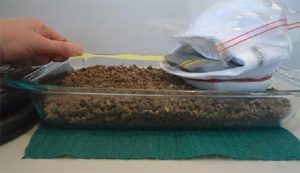
We interviewed forensic soil scientist Kathleen Murray to talk about her study: Soil Transference Patterns on Bras: Image Processing and Laboratory Dragging Experiments.
What is forensic soil analysis?
Forensic soil analysis is used by forensic soil experts and police forensic investigators to provide evidence to help police solve crime. In major crimes with no fingerprint or DNA evidence or reliable witness testimony, soil evidence can help police target their enquiries towards a particular suspect or location. Soil evidence can be even more valuable when it enhances other supporting evidence.
Trace soil evidence is often overlooked by criminals trying to remove all evidence of their crime. When two surfaces come into contact, such as shoes or clothing belonging to a victim/suspect and a soil surface, there is potential for the mutual transfer of minute traces of material between them. Forensic soil scientists use different methods to analyse this soil evidence including visual analysis, light microscopy, Scanning Electron Microscopy and X-Ray Diffraction analysis.
How was it applied in this study?
The current approach to analyzing forensic soil evidence is to focus on profiling the chemistry of the soil to indicate a possible origin. Because of this focus, police photographs are not generally taken of soil mark/pattern evidence on suspects/victim’s clothing at the crime scene; before the body is moved or clothing removed. Instead, soil evidence is generally ignored until specific items are chosen for analysis by either police forensic investigators or forensic soil experts. This soil analysis begins once as much soil as possible is rigorously removed from clothing fabric. This removal may involve shaking soil particles from clothing into collection bags or even cutting out sections of soiled material. Not since Locard’s experiments in 1930 has anyone published methods to help police use soil marks/patterns on clothing to interpret what happened to a victim during or after a crime.
The aim of this research was to test whether soil patterns on fabric could provide police with a reliable method to interpret trace soil pattern evidence on clothing. During my research (some papers yet to be published), two methods of soil transfer have been tested; namely placing or dragging a simulated clothed human victim across a soil surface. Resulting trace soil patterns were analysed with ‘naked eye’ visual analysis and light microscopy. All soil samples underwent XRD analysis to test whether soil chemistry and mineralogy had influenced the resulting soil patterns on clothing fabric.
Soil evidence was analyzed for Munsell soil color using both a traditional naked eye technique and a new method I developed involving image processing analysis of digital photos of trace soil evidence on clothing. Trimble eCognition Developer image processing software was programmed to recognize a limited palette of 25 Munsell soil colors. Digital photographs of soil evidence on white clothing fabric was then analyzed to ascertain whether image processing software had the potential to offer police a more objective and accurate method of analyzing Munsell soil color than naked eye visual analysis and a cheaper, quicker and more accessible method than spectrophotometry.
Why was it so important for this case?
This research was instigated by a high-profile unsolved murder case from Western Australia. In this murder case, the only forensic evidence was soil evidence on the victim’s clothing and boots. The victim’s husband was put on trial but acquitted for her murder. Because of the lack of published papers that offered a scientific interpretation of trace soil patterns on clothing, the judge could not accept the police interpretation of what happened to the victim during or after the attack, beyond reasonable doubt.
Soil is comparable to a human fingerprint in its uniqueness. Why is that?
Soil will never be as uniquely individual as the patterns formed by ridgelines on a human fingerprint. Even identical twins have different fingerprint patterns. However, natural soil types are created from combinations of different parent rocks and organic materials, which undergo a large variety of geological and climatic processes to produce soil. The resulting soil will be relatively unique when compared with soil from different locations.
Human-altered or human-transported soil will often contain a combination of minerals or human-made items (such as glass or plastic particles) not normally found together in a natural environment. When soil samples from known locations are compared to unknown or ‘suspect’ trace soil evidence taken from shoes or clothing, similarities and differences in the unknown soil’s minerals, chemistry, biology and physical characteristics are documented.
When only trace amounts of soil have been transferred to clothing, it can be technically challenging for forensic soil scientists to confirm the soil’s origin.
Describe your role in the study.
Until this research was undertaken, there was no scientific method accepted in a court of law to interpret trace soil marks on items of clothing evidence. For my PhD project, I designed a series of soil transfer experiments, run both in the laboratory and field, to simulate a clothed human body either placed or dragged across a soil surface. After initially running experiments in the laboratory, I tested whether the trace soil marks identified under controlled laboratory conditions could also be documented under realistic conditions in the field. In this second series of experiment (in a paper soon to be published), a human rescue dummy dressed in a clean padded bra was dragged across different soil surfaces in the Royal Tasmanian Botanical Gardens in Hobart, Tasmania.
How did you choose which types of soils to use in the study?
Natural and human-made or human-altered Tasmanian soil samples were used in this study; to increase scientific understanding of how trace soil evidence that had originated from local soil sites would appear on different common clothing fabrics. (Although only one fabric types was investigated in this paper [Murray et al. (2016)], different common fabric types were tested in papers yet to be published).
Summary Table of Soil Morphology and Selected Chemical Properties
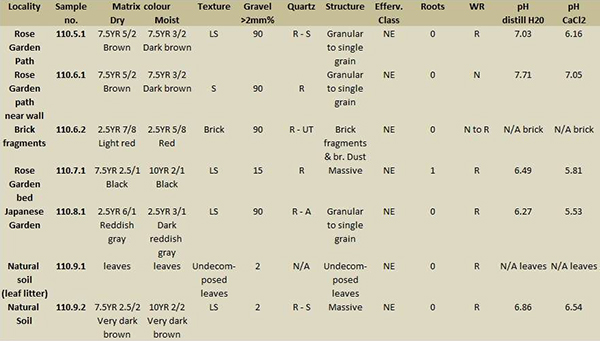
Texture: S, Sand; LS, Loamy Sand; obtained by the “feel” method in accordance with McDonald and Isbell (McDonald and Isbell 2009). Quartz = Quartz particles shape (Roundness and Sphericity): R = Rounded; S = Subrounded; UT = Subrounded tabular; A = Angular (McDonald and Isbell 2009). Effervescence Class (H4) (Reaction to 6N HCl): NE = Non effervescent; (Schoeneberger et al. 2002). Water Repellence (WR): N = Non water repellent; R = water repellent (McDonald and Isbell 2009). Roots: 0 = None; 1 = few (1-10 fine roots) in sample area 100mm² (McDonald and Isbell, 2009; p.199).
The bras were dragged across the soil surface for three seconds. How did you determine this to be the appropriate amount of time?
Three seconds was chosen as the optimum dragging time because of the dimensions of the glass Pyrex dish used in laboratory experiments. Each bra was secured to a weight and manually dragged in a straight line across the dish, using a drag line. To provide consistent and reproducible results, it was important that a continual dragging movement was achieved without any stopping or starting. It was also important that each ‘run’ moved at a controlled pace, without the need to rush. I personally found that three second dragging ‘runs’ enabled me to produce the most consistent results.
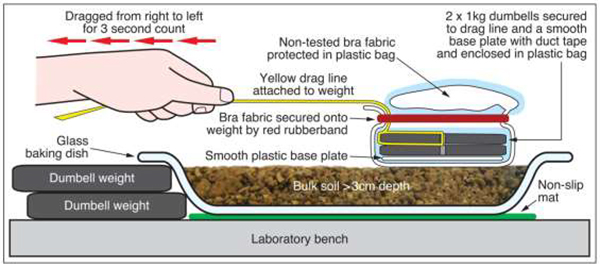
Cross-section of weighted bra dragged from right to left over soil material during a three second count soil transference experiment. Sections of bra that are not subjected to being dragged over the soil during the experiment remain clean inside a cliplock plastic bag on top of the weight. Note the end of the glass Pyrex dish containing soil material and weighted bra is placed on a nonslip mat and a backstop of weights on the left to stop it moving during the transference experiment.
What was unique about the soil transfer patterns?
During a series of soil transfer experiments, it was discovered that certain transfer patterns indicated whether soil had been transferred onto weighted clothing fabric either by dragging or placing a clothed victim on a soil surface. One soil pattern that strongly indicated a clothed victim had been dragged across soil was what I called ‘soil trails’. Like tyre ‘skid marks’ on a road, straight lines of soil particles on fabric indicated that an unmoving clothed victim (possibly dead, drugged, unconscious or bound) was dragged across a soil surface. It was also discovered that soil marks could indicate whether soil was wet or dry at the time it was transferred. Knowing the moisture content of trace soil might help police to narrow the time slot in which the crime was committed. Or in the event that a body was moved to a second location and the first crime scene location was not known, forensic investigators may be able to use meteorological records to focus their search on geographical areas with similar weather conditions.
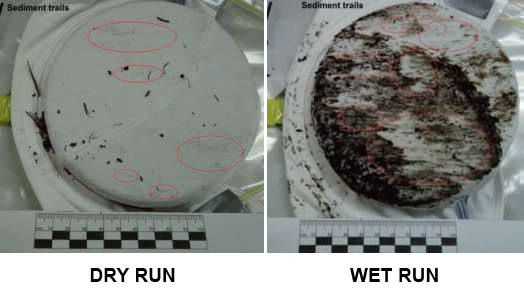
Soil trails on fabric, aligned with direction of movement right to left. The dramatic difference that can occur when soil from the same soil sample is transferred during a dry run (a) and wet run (b) is shown using natural soil sample (110.9.2). Notice also the massive build-up of soil over the raised middle seam and the minimal amount of soil transferred directly behind it.
Does it become more difficult to detect patterns if the fabric is colored?
This research was the first time image processing software was used to examine trace soil evidence on clothing fabric. To make this task easier, white fabric was chosen to provide a visual contrast to the color of all soils tested and thereby make it easier to identify microscope traces of soil particles transferred to clothing fabric.
Because soil comes in such a variety of colors, a more accurate method of detecting minute quantities of soil on multi-colored or patterned fabric will need to be developed to be of practical use to forensic investigators. One method to achieve this might be to programme image processing software to first identify clean sections of different clothing fabric textures. This might entail taking a digital photograph of a clean section of an item of clothing evidence. Another photograph of a soiled section of this clothing evidence would then be analysed to enable image processing software to better detect changes or ‘breaks’ in fabric texture patterns; when microscopic gaps in a woven fabric have been impregnated with soil particles.
How were the Munsell charts used?
Munsell soil color charts are routinely used in the field by soil scientists to determine soil color. In fact, Munsell soil color charts are used routinely by forensic soil scientists and geologists in the field and laboratory in most forensic investigations involving soil as evidence. “Soil color” is included in standard guidelines for conducting criminal and environmental soil forensic investigations in Australia and elsewhere in the world (Fitzpatrick and Raven 2016). As a consequence, Munsell soil colors have been used to help solve several major crime investigations such as when soil color, together with X-ray diffraction analyses, played a major role to solve a double murder case in South Australia (see Table 3 in Fitzpatrick and Raven 2012). During this research, Munsell charts were used to determine the soil color of known soil samples by traditional ‘naked eye’ analysis. Image processing software was also programmed to recognize the dominant range of Munsell colors from digital photographs of trace amounts of soil transferred to clothing fabric.
Munsell Colour of Moist and Dry Fine Fractions of Soil Samples
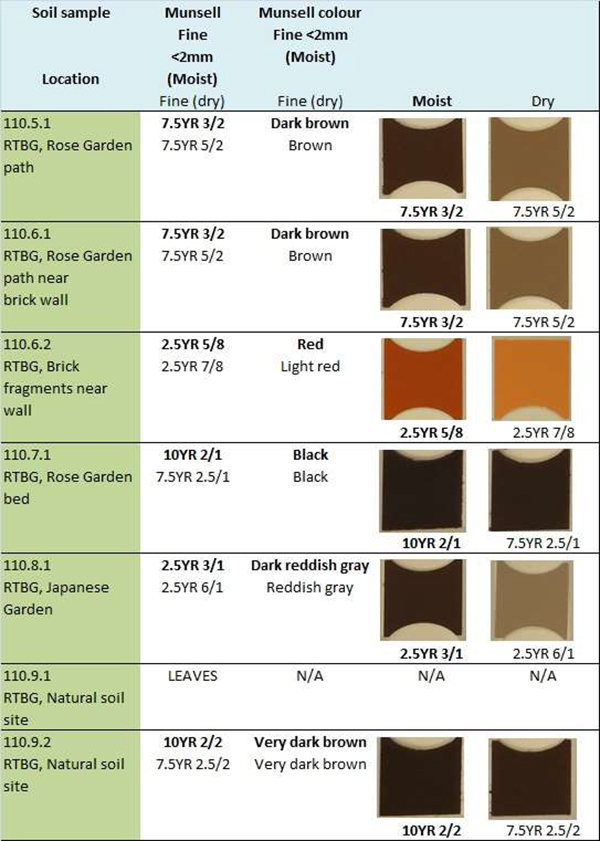
How did the use of Munsell charts help the study?
Although other color systems exist, as a forensic soil scientist, I prefer the simple and direct visual method soil color analysis the Munsell color systems provides. Because this system of soil color analysis is globally recognized, adopting this method enabled the results of this research to be understandable and relevant to forensic soil scientists and forensic investigators worldwide.
Why was the image processing analysis so important and how was it utilized in conjunction with the Munsell charts?
Image processing analysis was important in this study because every human retina is relatively unique and therefore soil color is not interpreted in exactly the same way by every soil scientist. It was hoped that image processing software could be programmed to provide a reliable and accessible method of objectively and accurately determining the Munsell soil color of trace amounts of soil evidence on clothing fabric. Although spectrophotometers have been designed to fulfill this purpose, they are not always accessible to forensic scientists analyzing soil evidence at crime scenes or in the laboratory.
Image processing analysis also enabled a range of dominant Munsell soil colors to be identified for microscopic traces of soil evidence on clothing fabric. When image processing software was programmed to recognize a limited palette of Munsell soil colors, this resulted in dominant color peaks; reminiscent of mineralogical peaks seen in XRD analyses of soil evidence.
Image processing software was also programmed to identify the ‘directionality’ of individual soil particles greater than 2mm diameter. When this numerical data was graphed in a rose diagram, this provided a strong indication of whether soil had been transferred to clothing fabric by placing or dragging a clothed body on a soil surface.
Munsell Soil Colour Range of Soil Transferred to Fabric in Pixels
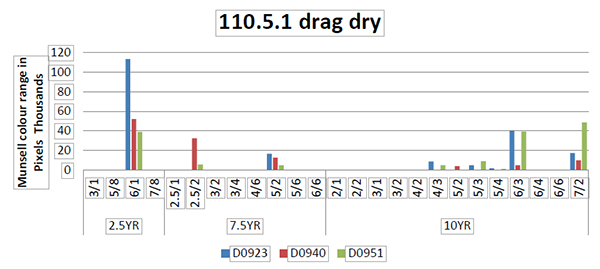
Munsell soil colour range recognised by image processing software of soil from the Rose garden path (110.5.1) transferred onto fabric when soil was dry.
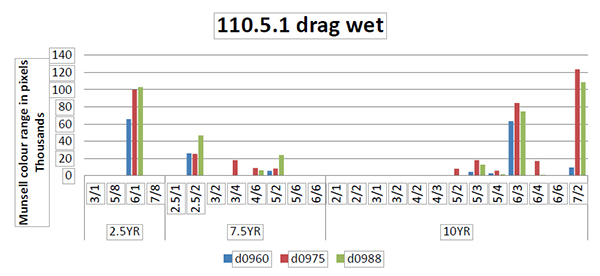
Munsell soil colour range recognised by image processing software of soil from the Rose garden path (110.5.1) transferred onto fabric when soil was moist.
How can this study be used at a crime scene?
By taking digital photographs of soil evidence on a simulated clothed body under artificial lighting in a laboratory and natural lighting in the field, it was hoped image processing software could be programmed to adjust for different lighting conditions in order to identify trace soil evidence on clothing fabric, and specific characteristics such as soil color, using this photographic evidence alone.
Because trace soil patterns on clothing fabric can be easily disfigured or destroyed when a body is moved or clothing removed, two methods of recognising and recording trace soil evidence on clothing were developed; namely a visual ‘naked eye’ method and image processing. Most trace soil patterns could easily be identified by naked eye. However, digital photographs provided a pristine record of this soil evidence for further analysis.
For forensic laboratories facing a massive backlog of soil evidence waiting to be analysed, or police in developing nations who do not have access to expensive XRD machines, spectrophotometers or trained personnel required to interpret forensic soil results, pre-programmed image processing software may enable quick in-house testing of forensic soil evidence. If the Munsell color of trace soil evidence on a victim’s clothing is analysed by image processing software as being very similar to soil evidence from a particular suspect’s clothing or shoes, this may provide police with a targeted focus for immediate investigation.
Directional Numerical Data Provided by Image Processing Software
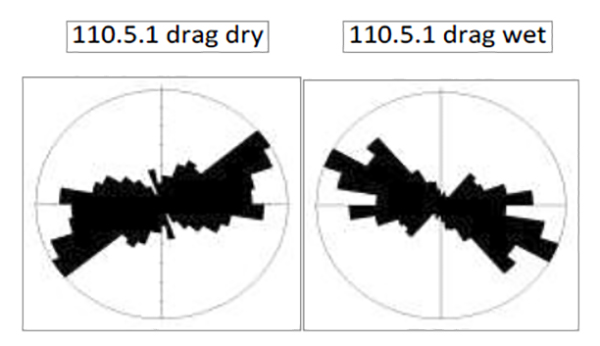
Rose diagrams of the directionality of dry and moist soil transferred onto fabric during STEs. Strong uni-modal directionality was produced when fabric was dragged from right to left across the soil surface. Dry soil particles had a greater tendency than wet soil to gather against the middle seam, creating more of a bi-modal directionality.
How can evidence like this be used in a court of law?
The concept of conducting and interpreting soil transference experiments on clothing for a specific purpose, as published in our SFI journal paper, provided the catalyst and confidence for my co-author Professor Rob Fitzpatrick to design and conduct a new series of specific soil transference experiments in regard to a cold murder case in South Australia. The results of his soil transference experiments, which involved conducting laboratory transference shaking experiments with clean strips of pajama-top fabric, used Scanning Electron Microscopy to verify that the mineral particles were dominantly on the surface of the pajama fabric. Whereas, in the questioned pajama-top swatches, the particles were deeply impregnated in gaps between fibres of the fabric; which likely originated under water with force being applied on the pajama top. This information, together with other soil mineralogical data, was used by Professor Rob Fitzpatrick as evidence in the South Australian Supreme Court.
Was there anything about the results of the study that surprised you?
When I was first asked to design a method for interpreting trace soil evidence on clothing as evidence of the circumstances of an attack, it was not known whether trace soil patterns could be identified, let alone reliably reproduced. Once I had successfully identified sets of trace soil patterns under laboratory conditions that could be used to establish that a clothed victim had been dragged across a soil surface, it was not known whether these same patterns could be identified in the field using a clothed human rescue dummy. (The results of this second set of experiments are soon to be published.) I was pleasantly surprised when the same trace soil patterns were also recognized on clothing fabric in the field. A new set of trace soil patterns were also documented when the human rescue dummy was only placed on soil and not dragged across it. This was the strongest indication that this new method of forensic soil analysis could be used by forensic soil scientists to help police solve crime.
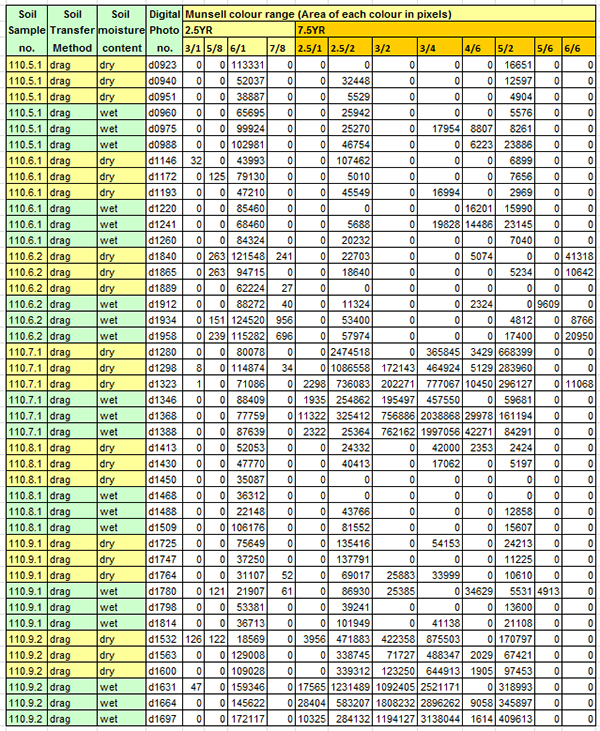
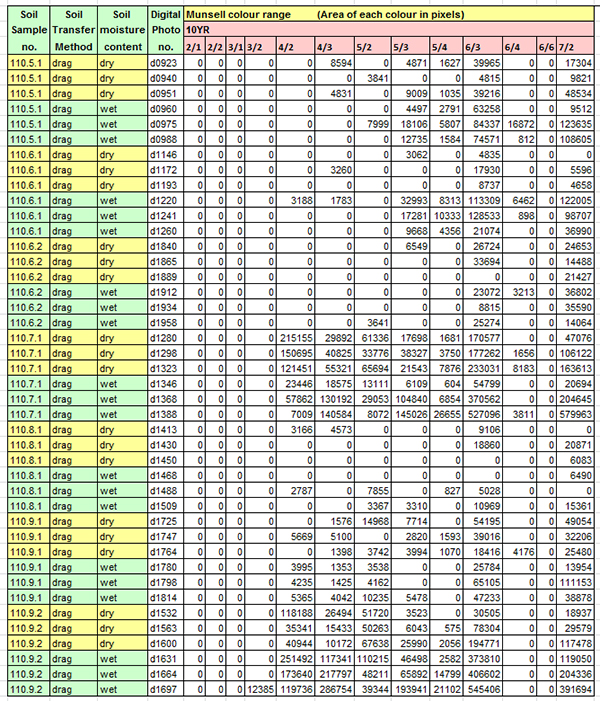
Are there any plans to further the study by looking at other soil types?
I have one paper soon to be published and another two papers submitted for publication. These final two papers broaden my research to include a larger variety of soil types from across Tasmania.
I currently do not have funding to continue my research in this new field of forensic soil analysis.
Do you feel that this study will extend well beyond this case in being able to help solve other crimes?
My research has shown trace soil patterns can be used to interpret the method of soil transfer to clothing and therefore the circumstances befalling a victim during or after an attack. It therefore has the potential to provide useful investigative evidence in crimes where soil has been transferred to items of clothing.
By treating trace soil patterns as a distinct form of forensic soil evidence, and preserving these patterns via digital photography at the crime scene before a body is moved or clothing removed, trace soil analysis could provide police with critical physical evidence of the circumstances befalling the victim, to be used as evidence during a criminal trial.
The original unsolved homicide that instigated this research was originally trialled in the Supreme Court of Western Australia. Under Western Australian law, there is no ‘double jeopardy’. Therefore, murder suspects could be tried again for the same crime if new evidence came to light.
Anything else you would like to share?
I am hoping that forensic soil scientists and computer software developers will team up to design purpose-built image processing software for analyzing trace soil evidence on clothing fabric, shoes, car tires, carpet, furniture and other items of evidence. A fully automated system that doesn’t require the operator to be a soil expert would be of most benefit to police and general forensic scientists.
Most police forensic laboratories do not test all clothing items associated with a major crime for soil evidence. This may be due to a massive backlog of soil evidence from other cases awaiting analysis, a lack of funding, limited access to XRD machines or lack of technical expertise. If image processing software was developed to provide police with a cheap, quick, accurate and accessible method of ‘in-house’ analysis of soil evidence on clothing, trace soil analysis may become as routine as DNA testing and fingerprint analysis. This image processing method might also be used to uncover new forensic soil evidence in cold case crimes for police to investigate.
References
Fitzpatrick R.W., and Raven M.D. (2016). Guidelines for Conducting Criminal and Environmental Soil Forensic Investigations (Version 10.1). Report CAFSS_076, Centre for Australian Forensic Soil Science, 46pp. http://www.adelaide.edu.au/directory/robert.fitzpatrick?dsn=directory.file;field=data;id=35757;m=view (accessed 11 February, 2016).
Fitzpatrick R.W. and Raven MD (2012) How Pedology and mineralogy helped solve a double murder case: Using forensics to inspire future generations of soil scientists. Soil Horizons. 53 (5). doi:10.2136/sh12-05-0016.
About the Authors
Kathleen Murray is a forensic soil scientist working to develop methods to assist police in solving criminal cases.
Professor Rob Fitzpatrick has focused on the interface of soil science (pedology), regolith science, mineralogy, biogeochemistry, forensic science, mineral exploration and climate change as applied to: landscape processes, advanced techniques to characterize, map, monitor and manage soil-regolith systems, criminal and environmental forensic techniques for soils and regolith, He has over 40 years experience in leading major multi-disciplinary research projects and has conducted over 500 specialized soil-regolith investigations and surveys, covering a wide range of regions and climates worldwide.
Professor Hilton Kobus has over 40 years experience in both operational and academic forensic science. He started in forensic science in Zimbabwe from 1968-1981 and moved to the Australian National University in 1981 as a research fellow funded by the Australian Federal Police investigating the science of fingerprint detection. He joined the Forensic Science South Australia (FSSA) in 1984 as Chief Scientist and became Director of FSSA from 1997-2007. In this role managed an organisation of 120 people that included pathologists, scientists, technicians and administrative personnel that provided broad ranging forensic science services to the South Australian Justice system. This period saw a significant expansion in the forensic science capability to South Australia with a major development being the establishment of a DNA database in support of criminal investigation.
Associate Professor Ron Berry has 30 years’ experience studying the geology of Tasmania. He is an Associate Professor in Geology at the University of Tasmania. Ron’s later research has focused on the emerging field of geometallurgy, using mineralogy and microtexture to predict processing performance in grinding and flotation. He has developed a protocol for automated mineral mapping using optical microscopy and mapping protocols for a laser Raman microscope.
Ralph Bottrill is a geologist, mineralogist, petrologist and mineral collector (from childhood). He works for Mineral Resources Tasmania, running the mineralogy/petrology labs and rock collection; studying various Tasmanian mineral deposits, rocks and minerals; analyzing and describing samples. He is an associate curator for minerals with both the Tasmanian Museum and the Queen Victoria Museum. He is currently President of the Mineralogical Society of Tasmania, and a member of the Mineralogical Society of Great Britain, the Mineralogical Association of Canada, the Society for Mineral Museum Professionals and the Specialist group for Geochemistry, Mineralogy and Petrology (Geological Society of Australia), He is an associate editor for the Australian Journal of Mineralogy and a registered valuer of minerals and meteorites under the Australian Cultural Heritage Act.
Click here to access the full study.



Leave a Reply